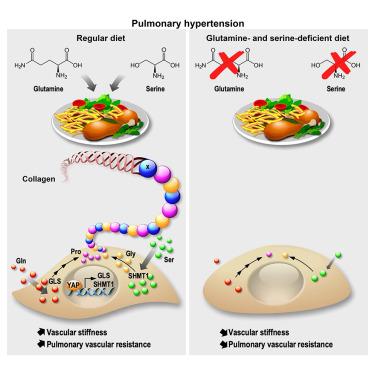当前位置:
X-MOL 学术
›
Cell Metab.
›
论文详情
Our official English website, www.x-mol.net, welcomes your feedback! (Note: you will need to create a separate account there.)
Dietary intake and glutamine-serine metabolism control pathologic vascular stiffness
Cell Metabolism ( IF 27.7 ) Pub Date : 2024-05-02 , DOI: 10.1016/j.cmet.2024.04.010 Nesrine S Rachedi 1 , Ying Tang 2 , Yi-Yin Tai 2 , Jingsi Zhao 2 , Caroline Chauvet 1 , Julien Grynblat 3 , Kouamé Kan Firmin Akoumia 4 , Leonard Estephan 2 , Stéphanie Torrino 1 , Chaima Sbai 1 , Amel Ait-Mouffok 1 , Joseph D Latoche 5 , Yassmin Al Aaraj 2 , Frederic Brau 1 , Sophie Abélanet 1 , Stephan Clavel 1 , Yingze Zhang 6 , Christelle Guillermier 7 , Naveen V G Kumar 8 , Sina Tavakoli 9 , Olaf Mercier 10 , Michael G Risbano 6 , Zhong-Ke Yao 11 , Guangli Yang 11 , Ouathek Ouerfelli 11 , Jason S Lewis 11 , David Montani 12 , Marc Humbert 10 , Matthew L Steinhauser 13 , Carolyn J Anderson 14 , William M Oldham 15 , Frédéric Perros 16 , Thomas Bertero 1 , Stephen Y Chan 2
Cell Metabolism ( IF 27.7 ) Pub Date : 2024-05-02 , DOI: 10.1016/j.cmet.2024.04.010 Nesrine S Rachedi 1 , Ying Tang 2 , Yi-Yin Tai 2 , Jingsi Zhao 2 , Caroline Chauvet 1 , Julien Grynblat 3 , Kouamé Kan Firmin Akoumia 4 , Leonard Estephan 2 , Stéphanie Torrino 1 , Chaima Sbai 1 , Amel Ait-Mouffok 1 , Joseph D Latoche 5 , Yassmin Al Aaraj 2 , Frederic Brau 1 , Sophie Abélanet 1 , Stephan Clavel 1 , Yingze Zhang 6 , Christelle Guillermier 7 , Naveen V G Kumar 8 , Sina Tavakoli 9 , Olaf Mercier 10 , Michael G Risbano 6 , Zhong-Ke Yao 11 , Guangli Yang 11 , Ouathek Ouerfelli 11 , Jason S Lewis 11 , David Montani 12 , Marc Humbert 10 , Matthew L Steinhauser 13 , Carolyn J Anderson 14 , William M Oldham 15 , Frédéric Perros 16 , Thomas Bertero 1 , Stephen Y Chan 2
Affiliation

|
Perivascular collagen deposition by activated fibroblasts promotes vascular stiffening and drives cardiovascular diseases such as pulmonary hypertension (PH). Whether and how vascular fibroblasts rewire their metabolism to sustain collagen biosynthesis remains unknown. Here, we found that inflammation, hypoxia, and mechanical stress converge on activating the transcriptional coactivators YAP and TAZ (WWTR1) in pulmonary arterial adventitial fibroblasts (PAAFs). Consequently, YAP and TAZ drive glutamine and serine catabolism to sustain proline and glycine anabolism and promote collagen biosynthesis. Pharmacologic or dietary intervention on proline and glycine anabolic demand decreases vascular stiffening and improves cardiovascular function in PH rodent models. By identifying the limiting metabolic pathways for vascular collagen biosynthesis, our findings provide guidance for incorporating metabolic and dietary interventions for treating cardiopulmonary vascular disease.
中文翻译:

膳食摄入和谷氨酰胺-丝氨酸代谢控制病理性血管僵硬度
活化的成纤维细胞引起的血管周围胶原蛋白沉积会促进血管硬化并引发肺动脉高压(PH)等心血管疾病。血管成纤维细胞是否以及如何重新连接其新陈代谢以维持胶原蛋白生物合成仍然未知。在这里,我们发现炎症、缺氧和机械应力共同激活肺动脉外膜成纤维细胞(PAAF)中的转录共激活因子 YAP 和 TAZ (WWTR1)。因此,YAP 和 TAZ 驱动谷氨酰胺和丝氨酸分解代谢,以维持脯氨酸和甘氨酸合成代谢并促进胶原蛋白生物合成。在 PH 啮齿动物模型中,对脯氨酸和甘氨酸合成代谢需求进行药物或饮食干预可减少血管硬化并改善心血管功能。通过确定血管胶原生物合成的限制代谢途径,我们的研究结果为结合代谢和饮食干预治疗心肺血管疾病提供了指导。
更新日期:2024-05-02
中文翻译:

膳食摄入和谷氨酰胺-丝氨酸代谢控制病理性血管僵硬度
活化的成纤维细胞引起的血管周围胶原蛋白沉积会促进血管硬化并引发肺动脉高压(PH)等心血管疾病。血管成纤维细胞是否以及如何重新连接其新陈代谢以维持胶原蛋白生物合成仍然未知。在这里,我们发现炎症、缺氧和机械应力共同激活肺动脉外膜成纤维细胞(PAAF)中的转录共激活因子 YAP 和 TAZ (WWTR1)。因此,YAP 和 TAZ 驱动谷氨酰胺和丝氨酸分解代谢,以维持脯氨酸和甘氨酸合成代谢并促进胶原蛋白生物合成。在 PH 啮齿动物模型中,对脯氨酸和甘氨酸合成代谢需求进行药物或饮食干预可减少血管硬化并改善心血管功能。通过确定血管胶原生物合成的限制代谢途径,我们的研究结果为结合代谢和饮食干预治疗心肺血管疾病提供了指导。
















































 京公网安备 11010802027423号
京公网安备 11010802027423号